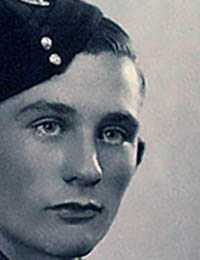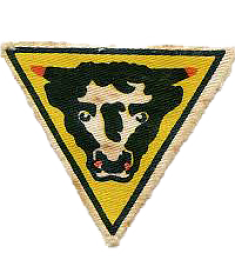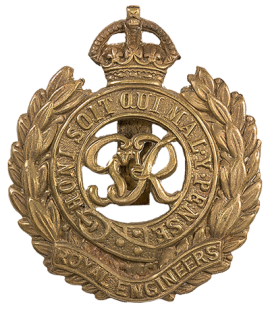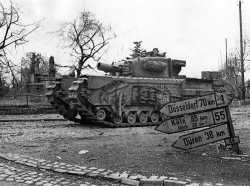I joined 6th Assault Regiment Royal Engineers shortly after my eighteenth birthday, having joined up on a Territorial engagement at the age of seventeen in the Spring of 1943. In March of 1944 the Division was ready to move to the South Coast in preparation. The Adjutant told me that I wouldn’t be going to France as at that time you had to be 19 to go abroad on active service, so I spent perhaps two weeks brooding in Felixstowe with the old soldiers etc. Parliament amended the age to eighteen and the Adjutant sent for me to join my unit, hidden in a pine forest near Calshott Castle. I was very pleased to meet the tank crews again at the final briefing,and wondered which crew I would be assigned to. Much to the amusement of my comrades, I was to man two radio sets on the C. O. ’s vehicle which meant traveling in a separate landing ship from the LVT’s used by the Armoured Vehicle Royal Engineers (AVRE).
After the delay for the weather we finally set sail about midnight on the 5th. Edging our way across the Channel we passed one of our largest battleships, just before first light. As we drew to the shore side of the monster it fired a broadside of it’s sixteen inch guns. It clearly moved sideways in the recoil. Our war was on! We also passed rocket launchers, never seen before, the shore line emerged in the distance. Everybody forgot about being sick in the rough seas and prepared to land. We were trying to make out what was happening on the beach when our ship hove to. There were a number of heated exchanges between our C.O. and the American Captain. Eventually, he allowed us to land from a raft. I could see and hear only the loudest explosions with a crackly headset on.
That’s how we landed on Gold beach when most of our AVRE’s were already off the beach and on their way to Ver-sur-Mer were fortunate, we owed our lives and a fairly uneventful landing to the AVRE’ and the Flails. Major Elphinstone, who was in command of all three lanes, opened his turret to deal with a problem and was immediately killed by a sniper. Our first casualty. We made our way to the rendezvous with 82 Squadron in an orchard south of Ver sur Mer. I was asked by an officer to look at a monastery which had been used as a barracks by the enemy. The Mess still had all the pictures of Hitler on the wall. The tables were littered as though it had been suddenly vacated and in the entrance hall was a dead body. I went to turn it over to identify it and the officer shouted “Don’t touch that,it’s probably booby-trapped!”.
That night I slept under the stars. The AVRE to which I was assigned already had a five man crew. This was because they had a demolition NCO on board so there was not room for six under the tank I had a piece of canvas that I found on the ship so with two pieces of rope I rigged up a hammock tied to the towing eye and a convenient fence. In the morning the crew thought it funny to start the engine. I jumped out as the tank moved forward and tore the hammock from the fence. However,I got my rightful place as the demolition NCO was reassigned.
These men had a tough job. They were in charge of the special explosives carried in the panniers of AVRE’s for special jobs. This is why, when an AVRE “brewed up” the heavy armoured side plates were completely blown off. Bayeux was captured intact and throughout the following weeks the nightly battles for the villages like Tilly sur Seulles and Hottot took up a lot of our time. Bocage country could be a nightmare, you could only see as far as the next field and in the lanes, only as far as the next bend. At night, German self-propelled guns stalked the hedgerows. The role of AVRE’s and the other specialised tanks in 79th Armoured Div. was to be assigned to troops engaged in specific tasks. Late June and early July was a time of assignment and days of standing down. It was times of the latter when the more bizarre experiences of war seemed to happen. One morning a squadron of Bostons flew overhead dropping bombs no more than half a mile from where we parked which shook us into the reality that the Germans were not far away. On one night a Fokke-wolf fighter flew low over our orchard and a comrade and I fired at it with a bren gun. We were immediately shouted at by a more experienced NCO who knew the folly of such action. The farmer however, came across to the bivouacs with a medicine bottle of the fiercest Calvados I have ever tasted.
The Bostons and the Typhoons that accompanied them meant only one thing, an enemy advance. We knew that Hitler had prevented Rommel from bringing up Panzer Divisions until now. The showdown was the most important battle of the campaign for northern France, Falaise. We moved during the night to an FUP, still surrounded by Bocage country, you couldn’t tell what was the other side of the hedge. The next morning, a truck arrived from 6th Assault HQ with a number of staff who really didn’t need to be there. We brewed up and I was taking a mug to my tank when a mortar bomb landed right on the spot at the back of the truck. I was blown several yards and when I came to I saw a hole near my groin. I took out the field dressing and was applying it when my crew arrived. I must have passed out again because when I regained consciousness I was in a medical half-track with three young Germans, two of whom were already dead. I was taken to an advance medical post in a farm outhouse. The young doctor, with a carpenters apron covered in blood, asked me to get up onto an old trestle. When I couldn’t he put me back on the stretcher and I was taken to Field Hospital near Bayeux. Two of my comrades visited me next morning and told me I was off to Blight. In an un-insulated DC2 it must have been at least 90 degrees, while airborne, it was freezing
We landed in an Oxfordshire base with a Hospital, where I spent several hours in a corridor. They operated on me but didn’t tell me that they were unable to reach the shrapnel. The next day they took me to Dudley Hospital in a ward of casualties from France. After another operation they also didn’t mention that they had not extracted the offending metal. It was finally discovered by an enthusiastic radiographer in 1991 and it remains where it has been for nearly sixty years.
After Dudley, it was a brief yet idyllic stay in a recuperating establishment on the banks of the Severn near the Wrekin. Soon I was off to a transit camp in Storrington, Sussex. In a few days I boarded an LVT which debarked us on the old quay at Boulogne. Lucky me! I was put on a 30cwt. and told that I would be joining my Unit near Antwerp. It was late September 44. Driving through the Escault tunnel, which had been bombed, we finally found elements of my unit on the other side. The very first person I saw was the RSM who said “Get back on the truck we’re going back through the tunnel”. The advance being temporarily reversed.
It was a couple of days before we were back through the tunnel again and on towards Holland. 82 Squadron played their part in the attack on Walcheren, a fairly heavily defended island in the mouth of the Scheldt. I, in the meantime was part of the forces which took over from the Canadians in that part of Holland west of the Scheldt. The invasion of Walcheren was mounted from Breskens where there was a small level of resistance actually in the town We were able to deal with that and the owner of a Cigar factory brought us cigars. The Buffaloe which was an amphibious troop carrier, played a very large part in capturing Breskens and in the much wider operation on Walcheren. The most lasting memory of this part of the campaign is of the weather. The country around Breskens was very cold and wet in November ‘44. We occupied some hollowed out hayricks with the inevitable rats. When the snow came I managed to develop “trench feet”. Fortunately the medicos were able to cut off my boots and socks and within a week I was walking again. About this time we received our first delivery of Tank Suits. That was the first time we had adequate clothing for the weather conditions. I didn’t take it off until Nijmegen.
Nijmegen in midwinter was a collection of 2nd Army and American troops. The failure at Arnhem, which was predictable, was as depressing as the lack of activity. Montgomery wanted the combined force to cross the Rhine but the Americans thought that the time was not right. Montgomery and Churchill undoubtedly thought that Arrnhem would be a great propaganda coup but failed to see that there were very experienced German troops in the area who sadly finished 6th Airbornes expectations. With the diversion of the Ardennes, where 79 Armoured troops were asked to support the defence, the winter dragged on until the advance to the Rhine. Breda,Tilburg, s’ Hertogenbosch and Weert. We made friends in Weert, our Signal Officer, the son of a Welsh Minister, studied Catholicism at night and later married his Dutch fiancee.
The Reichwald was perhaps the most depressing part of the war. We were not ‘liberating’ any more, the weather was atrocious and some of the villages we passed through were the most deprived that I had ever seen. East of the Maas the 31st Armoured Brigade supported by elements of 79 Armoured Div. set out for Geilenkirchen. On the 20th of November a troop of Avre’s destroyed five pillboxes in the Seigfried Line, worthy of historical mention. 16 Assault Squadron launched the first Skid Bailey bridge over a crater in the main road to Heinsberg. My Squadron also launched a Skid Bailey North of Wheeze’s wasn’t involved in that operation but had every respect for the tanks that did this, usually under fire.
One vivid memory of this period includes getting bogged down and then frozen in overnight. The flat bottom of the Churchill made a perfect bond with the ice and it took all day to free it. On the 5th of February 1,000 guns started a barrage that lasted five hours as the leading troops to cross the Rhine crossed the start line. We supported the 51st Division by laying two bridges and some fascines and petarding a pillbox. One bridge was useless because of the soft ground but the right hand one held up. On another lane two Avre’s broke their tracks, one with a facine and another lost it’s bridge. The mud and soft ground was a feature of the Reichswald. In the flooded parts the Canadians were reliant on Buffaloes. The flooding was part of the defences.
Without the Buffaloes the advance would scarcely have possible. Nevertheless, Goch and Cleve were taken. Flame from our Crocodile tanks was used in this advance. The Advance through Westphalia and up to the Baltic ports was a succession of major confrontations in which tanks of 79 Armoured were involved. From a personal view, the burning down of the gallows in Belsen was a moving experience. 10,000 bodies lay unburied and a further 13,000 died in the following days. I had the job of encouraging prisoners who had wandered off to return to the camp for registration.One group, in the bushes outside the perimeter, couldn’t be moved. They just sat there,expressionless.I just gave them some sweets and cigarettes that I kept in my map pocket. Meeting up with the Americans at the crossing of the Elbe, close to Luneburg heath, marshalling hundreds of prisoners and ironically, enjoying the Spring sunshine,was really the end of my war. Excepting driving through the ruins of Hamburg and ending upon VE day in Lubeck.
Harvey Smith



